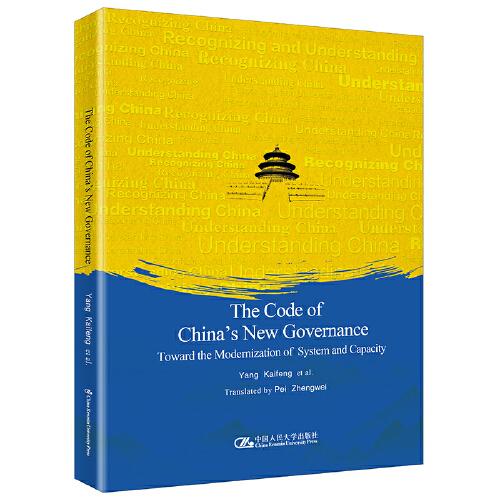中国之治——国家治理体系和治理能力现代化十五讲(英文版)
出版时间:
2021-06
版次:
1
ISBN:
9787300294469
定价:
228.00
装帧:
其他
开本:
16开
纸张:
胶版纸
页数:
364页
字数:
291千字
3人买过
-
What are the features of China’s national governance in terms of its institutional design? How does China organically integrate the Party, government agencies and diverse stakeholders such as market entities and social organizations to form the governance pattern of “pluralism under one core” and consultative co-governance? How does it fulfill the people-centered idea in all fields and at all levels of national governance? Focusing on those issues, this book analyzes a number of important aspects of China’s national governance, including institutional building, administrative system, economic governance, social welfare, social governance, emergency management, ecological civilization, and governance tools. Adopting perspectives of public administration, political science, economics and other disciplines, this book puts forward many new ideas and concepts. It is a key to understanding the “governance of China”. Yang Kaifeng is a professor and the executive dean of the School of Public Administration and Policy, Renmin University of China. He serves as the secretary general of the Public Administration Review Group under the Academic Degrees Committee of The State Council, as well as the secretary general of the National MPA (Masters of Public Administration) Education Steering Committee. He is also the editor-in-chief of Public Performance and Management Review and Public Administration and Policy Review. He has long been engaged in research and teaching on public administration, and has widely published in the areas of public governance, performance management, administrative reform, and public organizational theory, among others. He has published a number of books or monographs in Chinese or English, such as The Code of China\'s New Governance: Toward the Modernization of System and Capacity, Coordinated Implementation of Policies: Public Health Governance after the Epidemic, Handbook of Research Methods in Public Administration, and International Handbook for Practice-Based Performance Evaluation, etc. CONTENTS
Chapter 1Putting Institutional Building in a More Prominent Position of National Governance
1.Institutional logic of national governance
2.Overall logic of institutional building
3.Development logic of institutional building
4.Organizational logic of institutional building
5.Evaluation logic of institutional building
6.Constitutional logic of institutional building
7.Operational logic of institutional building
8.Behavioral logic of institutional building
9.Reform logic of institutional building
Chapter 2Construction of the “Four in One” Administrative System with Chinese Characteristics
1.One integration:To build a service?oriented government to satisfy the needs of the people
2.Integration of administrative organization
3.Simplification of administrative process
4.Efficiency of administrative methods
5.Decentralization of administrative relations
Chapter 3The Government Governance System of Ensuring Well?defined Responsibilities,Law?based Administration and Satisfing the Needs of the People
1.Well?defined responsibilities are the premise of
governance
2.Administrative system and organizations are the subject of government governance
3.Law?based administration is the inherent requirement of government governance
4.To satisfy the needs ofthe people is the aim of government governance
Chapter 4Some Issues on Modernization of China?s Economic System and Capacity for Governance
1.Systematic discussions on the modernization of China?s economic governance system and capacity
2.Strengthening the foundation of the national economic gover?nance system
3.Improving the national capacity for economic governance
4.Participating in the construction of international economic governance system
5.Ensuring and improving the people?s well?being
Chapter 5The Financial System Reform under the Background of China?s Governance
1.Financial system in the period of “sta
-
内容简介:
What are the features of China’s national governance in terms of its institutional design? How does China organically integrate the Party, government agencies and diverse stakeholders such as market entities and social organizations to form the governance pattern of “pluralism under one core” and consultative co-governance? How does it fulfill the people-centered idea in all fields and at all levels of national governance? Focusing on those issues, this book analyzes a number of important aspects of China’s national governance, including institutional building, administrative system, economic governance, social welfare, social governance, emergency management, ecological civilization, and governance tools. Adopting perspectives of public administration, political science, economics and other disciplines, this book puts forward many new ideas and concepts. It is a key to understanding the “governance of China”.
-
作者简介:
Yang Kaifeng is a professor and the executive dean of the School of Public Administration and Policy, Renmin University of China. He serves as the secretary general of the Public Administration Review Group under the Academic Degrees Committee of The State Council, as well as the secretary general of the National MPA (Masters of Public Administration) Education Steering Committee. He is also the editor-in-chief of Public Performance and Management Review and Public Administration and Policy Review. He has long been engaged in research and teaching on public administration, and has widely published in the areas of public governance, performance management, administrative reform, and public organizational theory, among others. He has published a number of books or monographs in Chinese or English, such as The Code of China\'s New Governance: Toward the Modernization of System and Capacity, Coordinated Implementation of Policies: Public Health Governance after the Epidemic, Handbook of Research Methods in Public Administration, and International Handbook for Practice-Based Performance Evaluation, etc.
-
目录:
CONTENTS
Chapter 1Putting Institutional Building in a More Prominent Position of National Governance
1.Institutional logic of national governance
2.Overall logic of institutional building
3.Development logic of institutional building
4.Organizational logic of institutional building
5.Evaluation logic of institutional building
6.Constitutional logic of institutional building
7.Operational logic of institutional building
8.Behavioral logic of institutional building
9.Reform logic of institutional building
Chapter 2Construction of the “Four in One” Administrative System with Chinese Characteristics
1.One integration:To build a service?oriented government to satisfy the needs of the people
2.Integration of administrative organization
3.Simplification of administrative process
4.Efficiency of administrative methods
5.Decentralization of administrative relations
Chapter 3The Government Governance System of Ensuring Well?defined Responsibilities,Law?based Administration and Satisfing the Needs of the People
1.Well?defined responsibilities are the premise of
governance
2.Administrative system and organizations are the subject of government governance
3.Law?based administration is the inherent requirement of government governance
4.To satisfy the needs ofthe people is the aim of government governance
Chapter 4Some Issues on Modernization of China?s Economic System and Capacity for Governance
1.Systematic discussions on the modernization of China?s economic governance system and capacity
2.Strengthening the foundation of the national economic gover?nance system
3.Improving the national capacity for economic governance
4.Participating in the construction of international economic governance system
5.Ensuring and improving the people?s well?being
Chapter 5The Financial System Reform under the Background of China?s Governance
1.Financial system in the period of “sta
查看详情
-
 2
2
全新
河北省保定市
平均发货29小时
成功完成率86.22%
-
全新
北京市朝阳区
平均发货12小时
成功完成率96.82%
-
全新
北京市房山区
平均发货25小时
成功完成率79.77%
-
全新
河北省保定市
平均发货29小时
成功完成率88.22%
-
全新
北京市朝阳区
平均发货11小时
成功完成率96.3%
-
全新
北京市房山区
平均发货20小时
成功完成率81.62%
-
全新
北京市房山区
平均发货15小时
成功完成率88.67%
-
全新
河北省保定市
平均发货33小时
成功完成率87.18%
-
全新
北京市朝阳区
平均发货12小时
成功完成率96.82%
-
九五品
江苏省无锡市
平均发货21小时
成功完成率84.26%
-
全新
山东省泰安市
平均发货15小时
成功完成率91.11%
-
九五品
河北省保定市
平均发货20小时
成功完成率84.6%
-
全新
江苏省南京市
平均发货6小时
成功完成率95.67%
-
全新
江苏省南京市
平均发货5小时
成功完成率98.24%
-
全新
江苏省南京市
平均发货14小时
成功完成率83.12%
-
 2
2
全新
江苏省无锡市
平均发货10小时
成功完成率96.74%
-
 2
2
全新
河北省保定市
平均发货15小时
成功完成率92.62%
-
全新
河北省保定市
平均发货27小时
成功完成率89.87%
-
全新
河北省保定市
平均发货29小时
成功完成率90.55%
-
全新
河北省保定市
平均发货34小时
成功完成率84.82%
-
全新
江苏省无锡市
平均发货5小时
成功完成率98.33%
-
全新
北京市西城区
平均发货11小时
成功完成率93.92%
-
全新
广东省广州市
平均发货17小时
成功完成率94.97%
-
全新
北京市海淀区
平均发货9小时
成功完成率97.72%
-
全新
江苏省无锡市
平均发货14小时
成功完成率94.99%
-
全新
广东省广州市
平均发货17小时
成功完成率94.49%
-
全新
北京市通州区
平均发货9小时
成功完成率93.67%
-
全新
上海市闵行区
平均发货26小时
成功完成率90.72%
-
全新
江苏省无锡市
平均发货15小时
成功完成率95.63%
-
全新
北京市通州区
平均发货9小时
成功完成率90.08%
-
全新
天津市河东区
平均发货24小时
成功完成率88.63%
-
全新
北京市顺义区
平均发货14小时
成功完成率96.4%
-
九品
北京市海淀区
平均发货22小时
成功完成率89.93%
-
九品
北京市东城区
平均发货25小时
成功完成率89.54%
-
全新
浙江省嘉兴市
平均发货13小时
成功完成率94.76%
-
全新
江苏省无锡市
平均发货8小时
成功完成率96.07%
-
全新
四川省成都市
平均发货33小时
成功完成率82.67%
-
九五品
江苏省无锡市
平均发货21小时
成功完成率84.26%
-
全新
天津市东丽区
平均发货20小时
成功完成率91.24%
-
九五品
河北省保定市
平均发货25小时
成功完成率79.46%
-
 5
5
全新
北京市丰台区
平均发货28小时
成功完成率85.98%
-
全新
江苏省南京市
平均发货14小时
成功完成率83.12%
-
全新
河北省保定市
平均发货27小时
成功完成率86.18%
-
全新
北京市东城区
平均发货10小时
成功完成率93.39%
-
全新
北京市朝阳区
平均发货18小时
成功完成率86.04%
-
全新
河北省保定市
平均发货33小时
成功完成率84.51%
-
九五品
河北省保定市
平均发货9小时
成功完成率11.86%
-
全新
北京市朝阳区
平均发货11小时
成功完成率96.3%
-
全新
广东省广州市
平均发货7小时
成功完成率93.31%
-
全新
江苏省无锡市
平均发货6小时
成功完成率95.67%

 占位居中
占位居中





























































